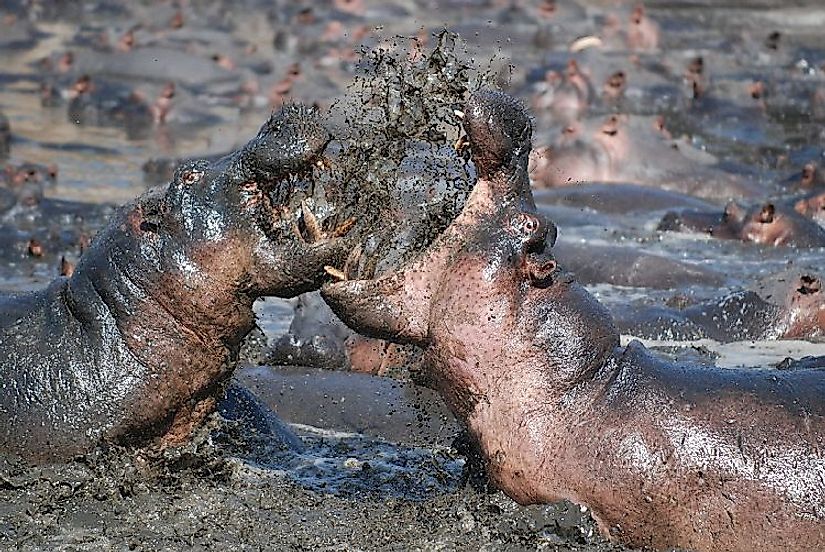Hippopotamus Facts

Physical Description
The Common Hippopotamus (Hippopotamus amphibious), a Greek-derived name that can be translated to mean “river horse”, is the third-largest terrestrial mammal, following only the white rhinoceros and the elephant. Biological taxonomists believe that they are closely related to whales, dolphins, and pigs. Hippos measure 12 to 15 feet in length, are 5 feet tall at the shoulder, and often weigh as much as 3.5 tons. The Hippopotamus has stumpy, short legs, with each foot having four webbed toes to support its plump and bulky body. The position of their ears, eyes and nostrils are on the top of its head, which allows them to observe their surroundings while the rest of their bodies are completely submerged in water. Hippo skin is gray with very few hairs, with a distinctively pink belly and pink colorations around the eyes, ears, and mouths. The two living species in the family Hippopotamidae are the “vulnerable” Common Hippo and the “endangered” Pygmy Hippo.
Diet
Like all ungulates, hippopotamuses are herbivores and mostly eat grass. They feed at night, starting at sunset, and can travel for long distances from their water sources to find the areas where they can graze. They can graze for about four to five hours at once during one feeding session, in which time they can eat around 88 pounds of grass, which is still a small fraction of their weight. They can manage to survive on such relatively low energy-dense foods because of their sedentary lifestyles, which does not utilize a large deal of energy expenditure compared to body size.
Habitat and Range
Hippopotamuses live in slow-moving rivers and lakes surrounded by grasslands. One can find them in the Southern and Central Africa, near the Nile River, and south of the Sahara Desert. The common hippopotamuses are not classified as endangered species, but instead a “vulnerable” one, with approximately 125,000 to 148,000 of them remaining in the world. Some of the biggest challenges to their populations include poaching them for their ivory teeth and flesh, along with habitat losses as human agricultural activities expand into their territories.
Where do Hippos Live?

Behavior
Hippos spend most of the hours during the day immersed in slow-moving waters in order to cope with the hot conditions of the African savanna. They live in groups, called “bloats”, of about 15 to 30 individuals, with the strongest male (or “bull”) dominating each group. The group size may be even higher during drought periods, as many hippos are forced to congregate near the limited water bodies. They constitute one of the most aggressive mammals in the word. Bulls often fight with each other over territory using their extensive canines to pierce one another, and can be very aggressive to any animal that confronts them. Despite their immense body, they can run up to a speed of 14 miles per hour, though not for long distances.
Reproduction
The dominant male in each bloat is the only one responsible for mating with the females. In case one of the other males tries to mate with one of the females, the dominant bull will scare the intruder by producing a loud bellowing noise and opening its jaws wide. A vicious fight will result if the intruder fails to back down, and the winner gains the right of mating the females in that bloat. Hippos usually mate in water. The female’s age of reproductive maturity comes at about six years. After copulation and conception, hippos have a gestation period of around eight months, they will generally deliver a single calf every two years, and the females give birth underwater. Hippos can nurse their newborn calves both underwater and on land, as these calves can close their nostrils and ears as they feed while submerged.
Facts About Hippos
| Animal Facts | Info |
|---|---|
| Length | 10-11 ft. |
| Height | 5 ft. |
| Weight | 3300-7000 lbs. (Male) 3300 lbs. (Female) |
| Sexual Maturity | 6-10 years although It is unlikely that young bulls are allowed to breed effectively until much older at about 20 years (Male) 7-12 years (Female) |
| Birth Season | Coincides with rainy season |
| Gestation | 240 days |
| Number Of Young | Single Young (2 years between pregnancies) |
| Habit | Sociable, living in groups of 10-20 but can be up to 150 |
| Lifespan | 45-50 years |
| Diet | Grasses |
| Related Species | The hippo family includes the rarer pygmy hippopotamus |







